Every stroke is different
Heart disease has taken a toll on both my mother’s and my father’s sides of the family. However, I would never have imagined the direct and personal assault it would have on me or my immediate family until this past fall.
For weeks, my mother prayed the rosary on the phone with her sister, who was dying of colorectal cancer. Their conversations were carried out each morning over a period of hours, with a very slow cadence. After my aunt died, I thought nothing of my mother’s slower speech pattern. That was until she started to pass out and have muscle weakness.
One day, while I was at school at the university, my father had to take her to the emergency room of our local hospital. I was two bites into a cheeseburger when he called me.
“Connor, we’re not sure what’s going on so try not to be worried, but I’m at the hospital with mom and they think she may have had a stroke,” he said. I completely lost my appetite.
She’s only 65, I thought. She eats so many fruits and vegetables, I insisted. How could this be?

She stayed in the hospital overnight, while doctors conducted a variety of tests to gauge what exactly happened. After about a week, we learned that they believed she’d had a transient ischemic attack (kind of a ministroke), where a clot in the blood supply to the brain is only temporary. After her discharge, an internist determined that she has hypercholesteremia (a factor that likely has contributed).
My mother is now seeing a neurologist, and the situation may be more complex than what was originally hypothesized by physicians. She has changed her diet, has been put on statins, and is trying to exercise daily.
She is quick to brush away the notion that she has ever had a stroke, but, in the back of my mind, the thought is always there. So now, it is imperative that I am not only more aware but more prepared.
What to look for
Heart disease has continued to be a great public health burden not only in the Western world but globally, with millions passing away every year from coronary artery disease and strokes taking the majority of lives in both developed and underdeveloped countries.
May is National Stroke Awareness Month and is a great opportunity to become more aware and possibly save a life.
F.A.S.T. Many if not all of you are familiar with the acronym, but what does it actually mean? Facial drooping, arm weakness, speech difficulty and time (time to call emergency services).
Despite this simple acronym, there are other symptoms of an impending or occurring stroke that may alter on a case-by-case basis. The Centers for Disease Control and Prevention advise that a sudden and severe headache, dizziness or imbalance as well as confusion can also indicate a stroke in progress.
But take note: Not all strokes are the same. A stroke can be broadly characterized into two distinct categories: ischemic, where there is a block in a blood vessel supplying blood to the brain, and hemorrhagic, where there is bleeding into or around the brain. The rates of ischemic stroke are rising among young adults.
Since the brain controls the functions of the rest of the body, the effects of a stroke can often be systemic. To gain a broader understanding of a stroke, check out these resources from the National Institute of Neurological Disorders and Stroke.
Become a stroke hero by recognizing these signs, and check out some of the novel research being conducted below to advance our understanding of various aspects of cerebrovascular pathology.
Recent research
Exploring the relationship between stroke severity and glycocalyx dysfunction: Researchers working in multiple labs across Japan hoped to better understand the degradation of the endothelial glycocalyx of the blood–brain barrier after ischemic stroke. Most if not all cells in the human body are covered in the glycocalyx, a sugary coating of various polysaccharides linked to proteins with phenomenal diversity. Although the glycocalyx serves many different roles — including cellular recognition, signaling and structural stability — this study focused on its protective role of the cells that guard the blood–brain barrier. The team showed that in the hyperacute phase after a stroke (within a few hours of onset) there is a dramatic decrease in the levels of chondroitin sulfate and heparan sulfate glycosaminoglycans in brain tissue, while there is an increase in the expression of enzymes that digest these polymers. The researchers also identified a modified form of a precursor enzyme targeting heparan sulfate, which they suggested is a promising target for protecting stroke victims from subsequent inflammation in the brain. Read the paper.
Chatty fats: lipid signaling in the atherosclerotic state and implications for cerebrovascular events: A translational research team from labs in the Netherlands and China wanted to take a closer look at the role lipids play in the development and progression of atherosclerosis. While atherosclerosis in general refers to the buildup of plaque, fats and cholesterol in the artery walls, the location of plaque makes a big difference. When this buildup occurs somewhere between the heart and the brain, such as in the carotid artery, it can pose a serious risk for a cerebrovascular event, such as a stroke. Using highly sensitive analytical methods (MALDI-TOF MSI), the researchers characterized and identified unique lipid profiles in human atherosclerotic plaques in the largest atherosclerotic dataset to date. They found there was a clear association of plaque development with specific lipid classes in these samples and potentially identified biomarkers using these lipids to identify high-risk patients. Take a look at their work.
X marks the spot: Identification of potential biomarkers and complex signaling networks in ischemic stroke: It is incredibly important for clinicians to have the most useful indicators of stroke for diagnosis, prognosis and subsequent treatment. Yet, there is still a great deal of work to be done to understand the molecular features of the complex state of a stroke. A team of researchers from Spain set out to integrate a large set of proteomic and transcriptomic data to unravel the molecular interactions and signaling secrets of the acute phase of a stroke. They performed extensive analysis of brain and blood samples from mice as well as humans exhibiting stroke-mimicking symptoms. They found differential expression of many genes and proteins after stroke onset, with two genes in particular potentially being useful as indicators for stroke diagnosis and prognosis. Learn more about their research.
Enjoy reading ASBMB Today?
Become a member to receive the print edition four times a year and the digital edition monthly.
Learn moreGet the latest from ASBMB Today
Enter your email address, and we’ll send you a weekly email with recent articles, interviews and more.
Latest in Science
Science highlights or most popular articles

Fueling healthier aging, connecting metabolism stress and time
Biochemist Melanie McReynolds investigates how metabolism and stress shape the aging process. Her research on NAD+, a molecule central to cellular energy, reveals how maintaining its balance could promote healthier, longer lives.

Mapping proteins, one side chain at a time
Roland Dunbrack Jr. will receive the ASBMB DeLano Award for Computational Biosciences at the ASBMB Annual Meeting, March 7–10, just outside of Washington, D.C.

Exploring the link between lipids and longevity
Meng Wang will present her work on metabolism and aging at the ASBMB Annual Meeting, March 7-10, just outside of Washington, D.C.

Defining a ‘crucial gatekeeper’ of lipid metabolism
George Carman receives the Herbert Tabor Research Award at the ASBMB Annual Meeting, March 7–10, just outside of Washington, D.C.

The science of staying strong
Muscles power every movement, but they also tell the story of aging itself. Scientists are uncovering how strength fades, why some species resist it and what lifestyle and molecular clues could help preserve muscle health for life.

Bacteriophage protein could make queso fresco safer
Researchers characterized the structure and function of PlyP100, a bacteriophage protein that shows promise as a food-safe antimicrobial for preventing Listeria monocytogenes growth in fresh cheeses.

